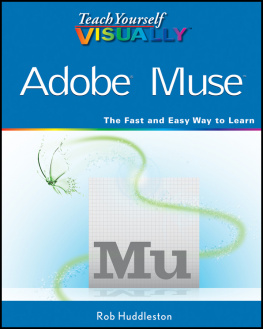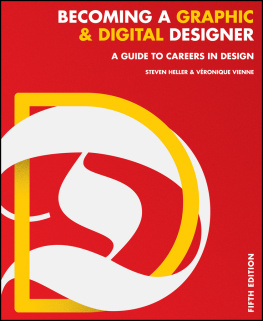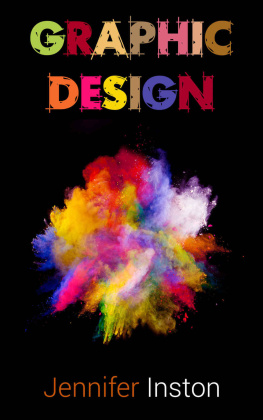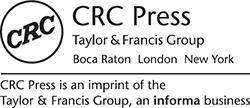Contents
Page List

Graphic Design
Learn It, Do It
Graphic Design
Learn It, Do It
Katherine A. Hughes
CRC Press
Taylor & Francis Group
6000 Broken Sound Parkway NW, Suite 300
Boca Raton, FL 33487-2742
2019 by Taylor & Francis Group, LLC
CRC Press is an imprint of Taylor & Francis Group, an Informa business
All images Katherine A. Hughes unless otherwise noted
No claim to original U.S. Government works
Printed on acid-free paper
International Standard Book Number-13: 978-0-367-07536-1 (Hardback)
978-0-367-07534-7 (Paperback)
This book contains information obtained from authentic and highly regarded sources. Reasonable efforts have been made to publish reliable data and information, but the author and publisher cannot assume responsibility for the validity of all materials or the consequences of their use. The authors and publishers have attempted to trace the copyright holders of all material reproduced in this publication and apologize to copyright holders if permission to publish in this form has not been obtained. If any copyright material has not been acknowledged please write and let us know so we may rectify in any future reprint.
Except as permitted under U.S. Copyright Law, no part of this book may be reprinted, reproduced, transmitted, or utilized in any form by any electronic, mechanical, or other means, now known or hereafter invented, including photocopying, microfilming, and recording, or in any information storage or retrieval system, without written permission from the publishers.
For permission to photocopy or use material electronically from this work, please access www.copyright.com (http://www.copyright.com/) or contact the Copyright Clearance Center, Inc. (CCC), 222 Rosewood Drive, Danvers, MA 01923, 978-750-8400. CCC is a not-for-profit organization that provides licenses and registration for a variety of users. For organizations that have been granted a photocopy license by the CCC, a separate system of payment has been arranged.
Trademark Notice: Product or corporate names may be trademarks or registered trademarks, and are used only for identification and explanation without intent to infringe.
Visit the Taylor & Francis Web site at
http://www.taylorandfrancis.com
and the CRC Press Web site at
http://www.crcpress.com
Contents
This book is dedicated to my parents, Paul and Betsy Hughes. Thank you for your constant support and encouragement, and access to your traveling writing station.
The author would also like to thank her students, from whom she has learned so much.

Katherine A. Hughes , PhD, is an educator, a traveler and a photographer. Katherine began her career as a multimedia producer and project manager for a series of dot com companies. After earning her doctoral degree in mass communications from the S.I. Newhouse School of Public Communications at Syracuse University, she returned to the university classroom teaching communication courses in graphic design, digital photography and online content development. When not in the classroom, Katherine is likely on the road exploring the national parks or planning her next study abroad program.
Graphic Design: Learn It, Do It is an introduction to the fundamentals of graphic design and the software applications used to put these concepts into practice, specifically Adobe Photoshop CC, Illustrator CC and InDesign CC. This book is intended for production-oriented audiences, those interested in the what, why and how of graphic design.
The what is effective graphic designusing the elements of design and design principles to create a visual solution (an image) that stands out in a crowded marketplace. This discussion includes color theory, typography and page layout.
Focus on the why of design begins with the reasons why we communicate; attention is paid to the motivation behind the visual solution, as well as to its audiences. The rationale is revisited throughout the design process, including reviews of output options (print vs. onscreen) and their related properties, including resolution, color mode and file format.
The how of design addresses the stages of production and the use of select Adobe Creative Cloud applications (i.e., Photoshop, Illustrator and InDesign) to translate an idea into a visual solution. Following an overview of each application and its uses, exercises are presented to foster familiarity with each applications workspace and the capabilities of its tools while featuring specific design concepts.
This book is based on the approach of learning , then doing , and thus the title, Graphic Design: Learn It, Do It . In a production-oriented environment, this approach translates to discussing the fundamental design principles, then experimenting with these concepts in the Adobe applications. Guided exercises are included to get the designer working in the applications; they are intended to serve as a jumping-off point, from which the designer is encouraged to continue exploring the Adobe applications and their capabilities.
The application portions of this book refer to the 2019 release of the Adobe Creative Cloud running on the macOS. These chapters include Mac-based screen captures of application interfaces and step-by-step instructions through specific tasks. Designers using other versions of the applications or a different platform may notice minor differences between their workspaces and those represented in this book; however, the underlying concepts and basic practices should be consistent.
Look for references to this books companion website throughout the text: http://www.crcpress.com/9780367075347. The files available for download from this site are provided to support the learn it , do it approach.
Lets get started.
Graphic design surrounds us. We engage graphic design both passively and actively. We experience images passively in the forms of banner ads or targeted advertisements displayed along the sides of a Web browser or in an app when we post a status update. Similarly, think about the signs passed traveling to school or work, roadside billboards and storefront signs. Against this background of visual noise, there are images that we actively seek. Consider the days news headlines or results from a recent sporting event; the type, photos and layouts used to present this information are components of graphic design. When a weather radar map is checked to track a band of approaching rain or snow, the colors used to represent the passing weather system have meaning; this too is a form of graphic design. Finally, think about the photos that are shared or viewed on social media. These photos reflect decisions made about the framing (what to include and exclude); the use of filters, lenses or emojis; and whether to include a text caption or a hashtag. These choices represent graphic design in action, decisions made to create an image that informs, inquires, persuades or merely entertains. These actions are at the core of why we communicate.
To Inform: We communicate in order to share messages or data with others. Our purpose is to educate or simply tell.
To Inquire: We communicate to solicit input from others. Our purpose is to gain knowledge and foster interactions.










